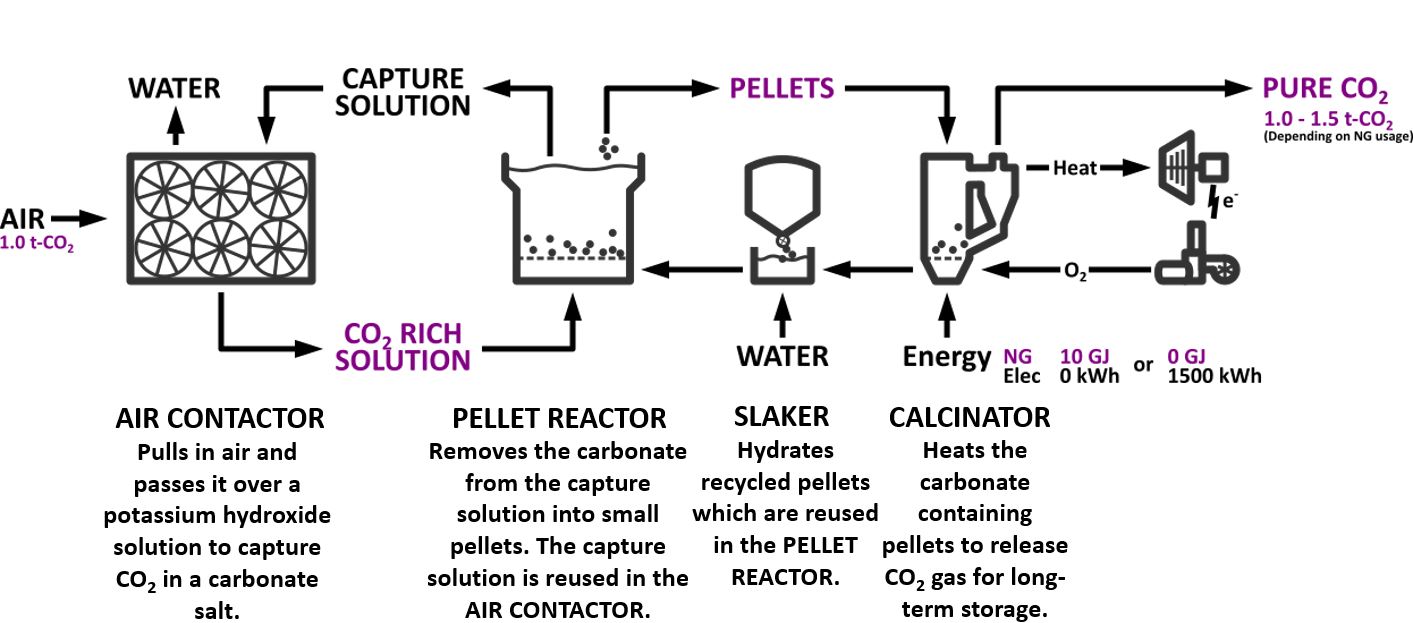Part
01
of one
Part
01
Carbon Dioxide Scrubbing
Key Findings
- A BBC report reveals that the Carbon Engineering system utilizes specially designed fans to draw air with approximately 0.04% carbon dioxide. The air is passed through a filter drenched in potassium hydroxide solution or potash.
- Potash is used in carbon dioxide scrubbing because it absorbs carbon dioxide from the air.
- The potassium hydroxide solution is then piped to another chamber and mixed with calcium hydroxide, which retains the dissolved carbon dioxide resulting in limestone flakes.
- Since the limestone flacks contain CO2, they are sieved off the solution and heated in another chamber called the calciner. The heating of the limestone flakes continues until they decompose and give off pure CO2. The CO2 is then stored.
Introduction
This research leverages publicly available sources to provide detailed findings on the carbon dioxide scrubbing. The research uses publicly available sources like scientific articles and websites like gas world, BBC Future, The Conversation and Energy. gov. The research provides an overview of the carbon dioxide scrubbing process and the different approaches used by companies to extract carbon dioxide from the atmosphere.
Findings
- A report by the BBC indicates that the world needs to do more than becoming carbon neutral to avoid the adverse impacts of climate change.
- The Intergovernmental Panel on Climate Change (IPCC) states that the target of limiting global warming to 1.5C by 2100 can only be achieved by leveraging technologies that enable the large-scale deployment of carbon dioxide from the atmosphere annually through a process called carbon dioxide scrubbing.
- Jane Zelikova, a climate scientist at the University of Wyoming, states that existing data models indicate that the world must remove at least 10 gigatonnes of carbon dioxide annually by 2050. The carbon dioxide that should be removed from the atmosphere by 3100 should increase to at least 20 gigatonnes yearly.
- Carbon dioxide scrubbing has attracted the interest of many world leaders and entrepreneurs like Bill Gates and Elon Musk. Companies like ExxonMobil, Microsoft, and United Airlines are already investing billions into the field of carbon dioxide scrubbing. In addition, Elon Musk recently pledged $100 million toward developing carbon dioxide scrubbing technologies.
- One of the few carbon dioxide scrubbers is found in British Columbia, and it is used as a test bed for different technologies in carbon scrubbing. There are, however, plans to build a larger plant in the oil fields of Texas that would scrub almost a million tons of carbon dioxide from the atmosphere.
- The image shows a carbon scrubber pilot plant that is located in British Columbia.
- A BBC report reveals that the Carbon Engineering system utilizes specially designed fans to draw air with approximately 0.04% carbon dioxide. The air is passed through a filter drenched in potassium hydroxide solution or potash, commonly used in soap making.
- Potash is used in carbon dioxide scrubbing because it absorbs carbon dioxide from the air. The solution is then piped to another chamber and mixed with calcium hydroxide, which retains the dissolved carbon dioxide resulting in limestone flakes.
- Since the limestone flacks contain CO2, they are sieved off the solution and heated in another chamber called the calciner. The heating of the limestone flakes continues until they decompose and give off pure CO2. The CO2 is then stored.
- In an article in the Conversation, D’Alessandro identified two main ways CO2 is removed from the atmosphere: enhancing carbon storage in a natural environment and direct air capture (DAC) technology.
- A Swiss company called Climeworks is one of the first to operate a commercial DAC system worldwide. The company has 15 direct air capture machines spread out across Europe. These machines are eco-friendly since they are powered by energy from burning waste or geothermal energy.
- The machines use large fans to draw air from the atmosphere into a collector. The collector is made up of a filter that captures CO2, which is then moved underground.
- A Canadian firm called Carbon engineering uses specially designed fans to extract air into its tower-like structure. The extracted air is passed through a potassium hydroxide solution that extracts carbon monoxide from the air. The extracted carbon monoxide is then purified and compressed.
- In most instances, the CO2 that is captured is pumped into the ground and used to extract oil. The CO2 is sometimes used to counteract the emissions from burning fossil fuels.
Research Strategy
The research was executed by leveraging credible and publicly available sources to provide insights into the carbon monoxide scrubbing process. The information was retrieved from publicly available scientific sources and magazines like the gas world, ocean front Squamish, energy.gov, and the IPCC website. I started the search by investigating the carbon monoxide scrubbing process before expanding to companies actively making strides in the relatively new fields.

